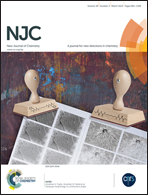N-heterocyclic carbene supported Au(i) and Au(iii) complexes: a comparison of cytotoxicities†
Abstract
The N-heterocyclic carbene (NHC) precursor 2-pyridin-2-yl-2H-imidazo[1,5-a]pyridin-4-ylium hexafluorophosphate (1·HPF6) was used to synthesize various Ag and Au complexes, including [Ag(1)2][PF6] (2), [Au(1)2][PF6] (3) and [Au(1)Cl3] (4). The structure of the silver(I) complex 2 was established via NMR spectroscopy, mass spectrometry and single crystal X-ray crystallography. The gold(I)–NHC complex 3 was synthesized via transmetallation of the aforementioned silver complex and characterized using various spectroscopic methods. Treatment of 3 with Au(SMe2)Cl afforded 4, ostensibly via a disproportionation process. Close inspection of the solid state structure of 2 revealed that the Ag(I) center adopted a linear geometry; in contrast, a square planar geometry was observed for the solid structure of 4. The cytotoxicities of the gold complexes 3 and 4 were tested in vitro against Human colorectal carcinoma (HCT 116), Human hepatocellular carcinoma (HepG2), Human breast adenocarcinoma (MCF-7) and Murine melanoma (B16F10). The measured IC50 values showed that the Au(I) complex 3 was more potent than the Au(III) complex 4 as well as cisplatin.


 Please wait while we load your content...
Please wait while we load your content...